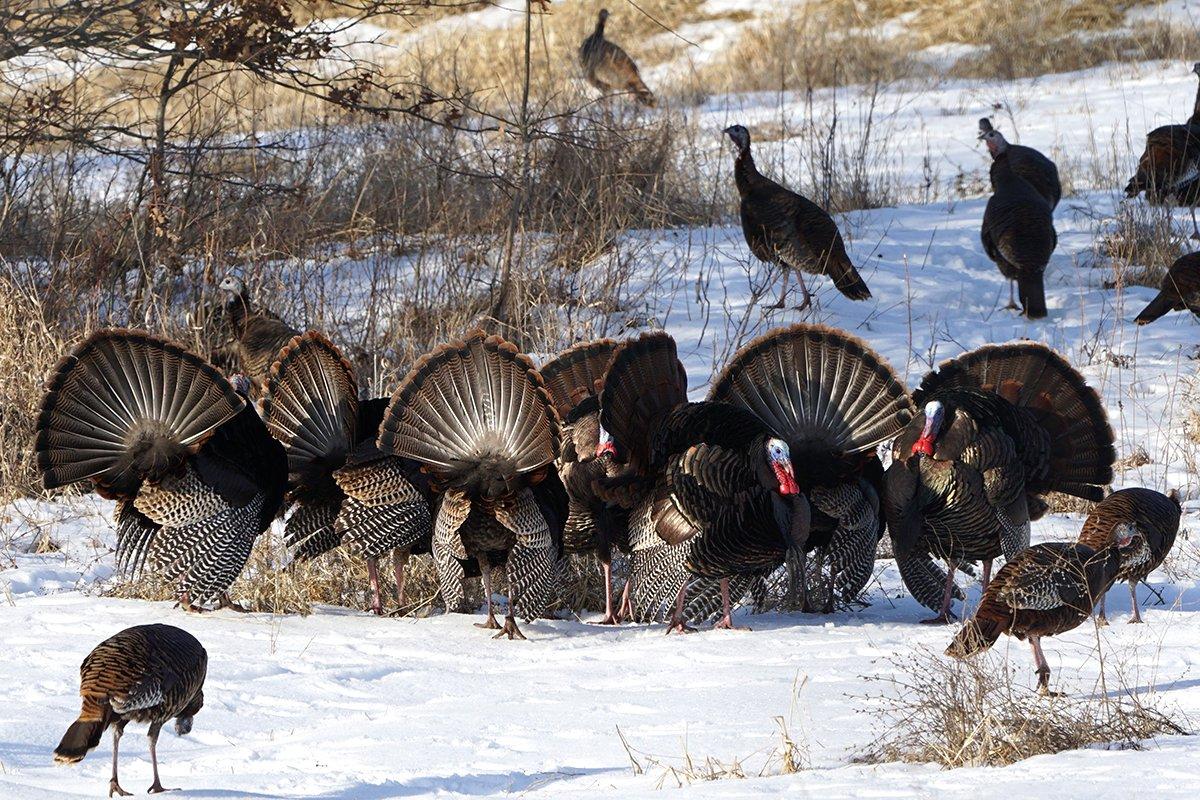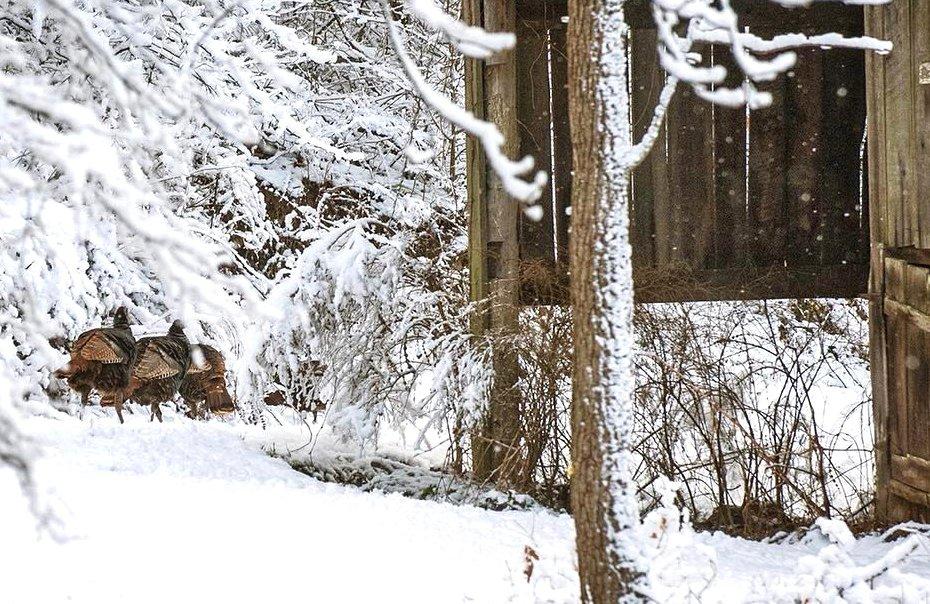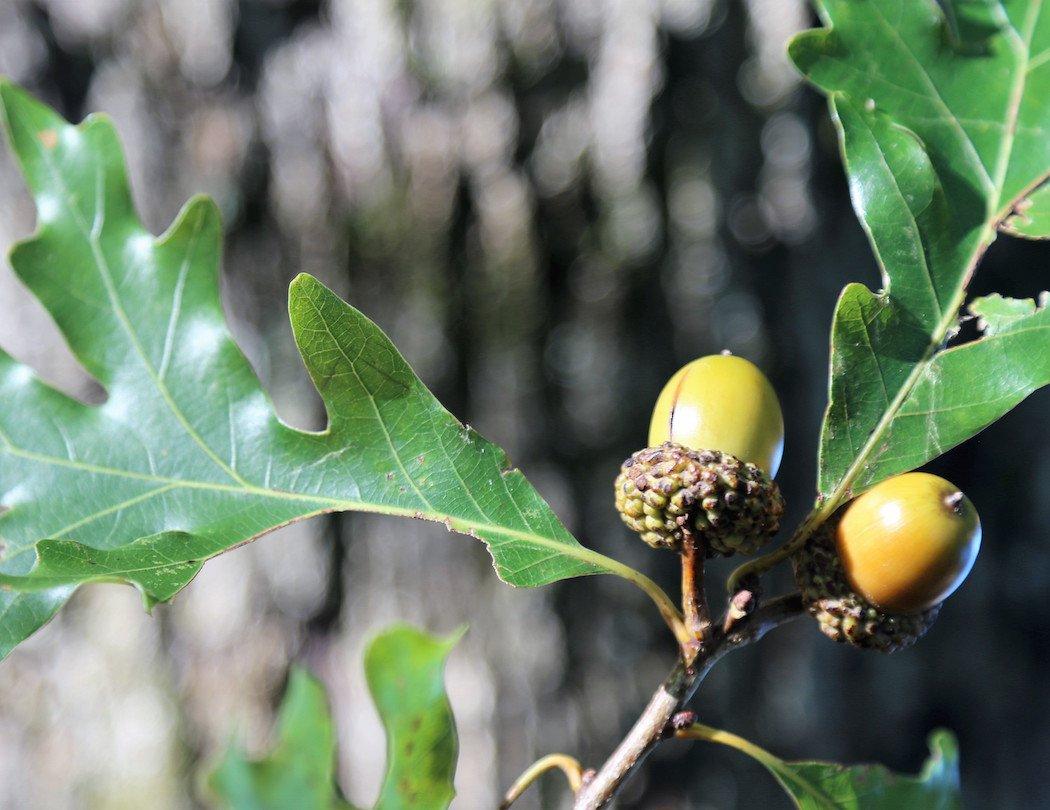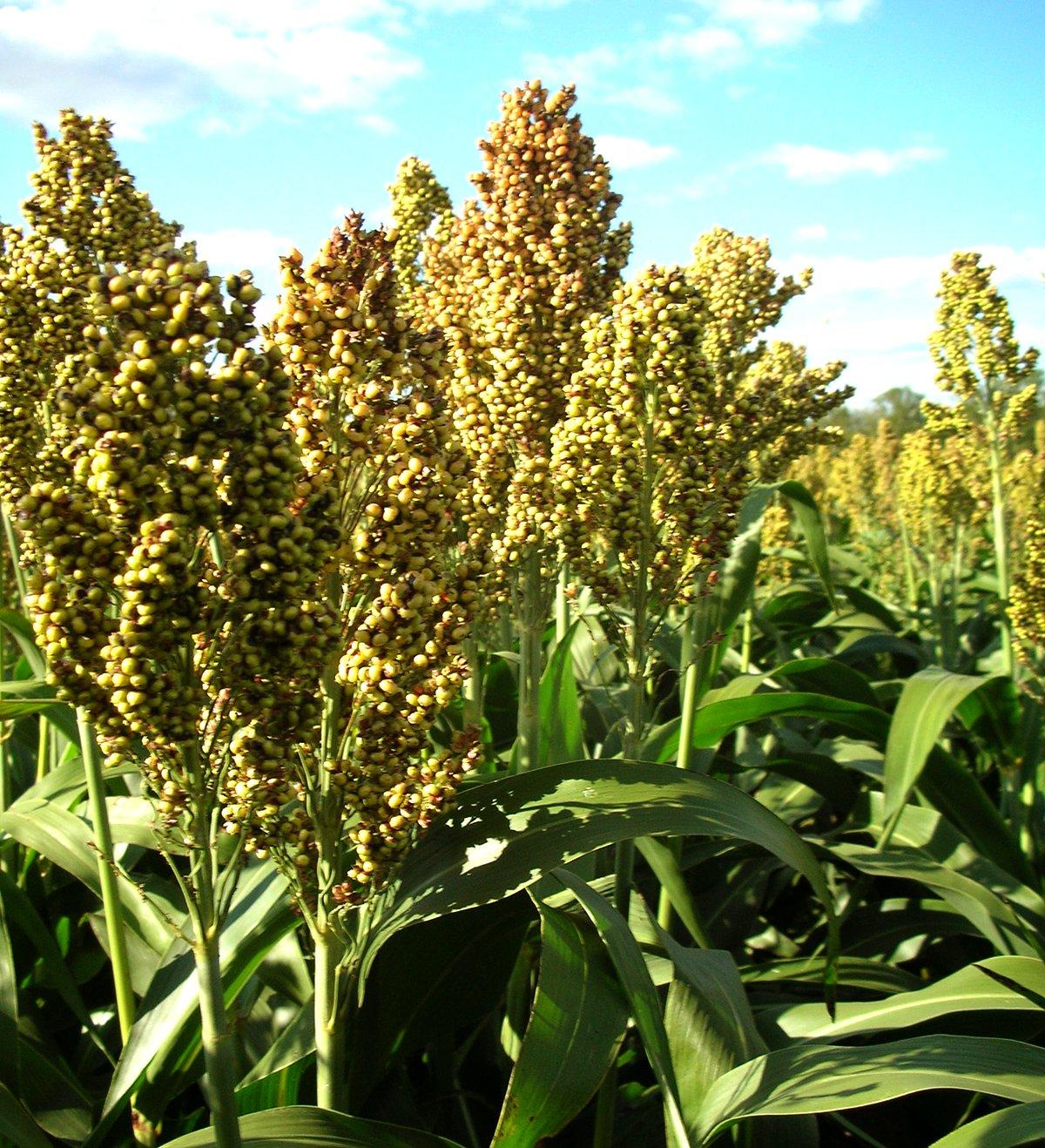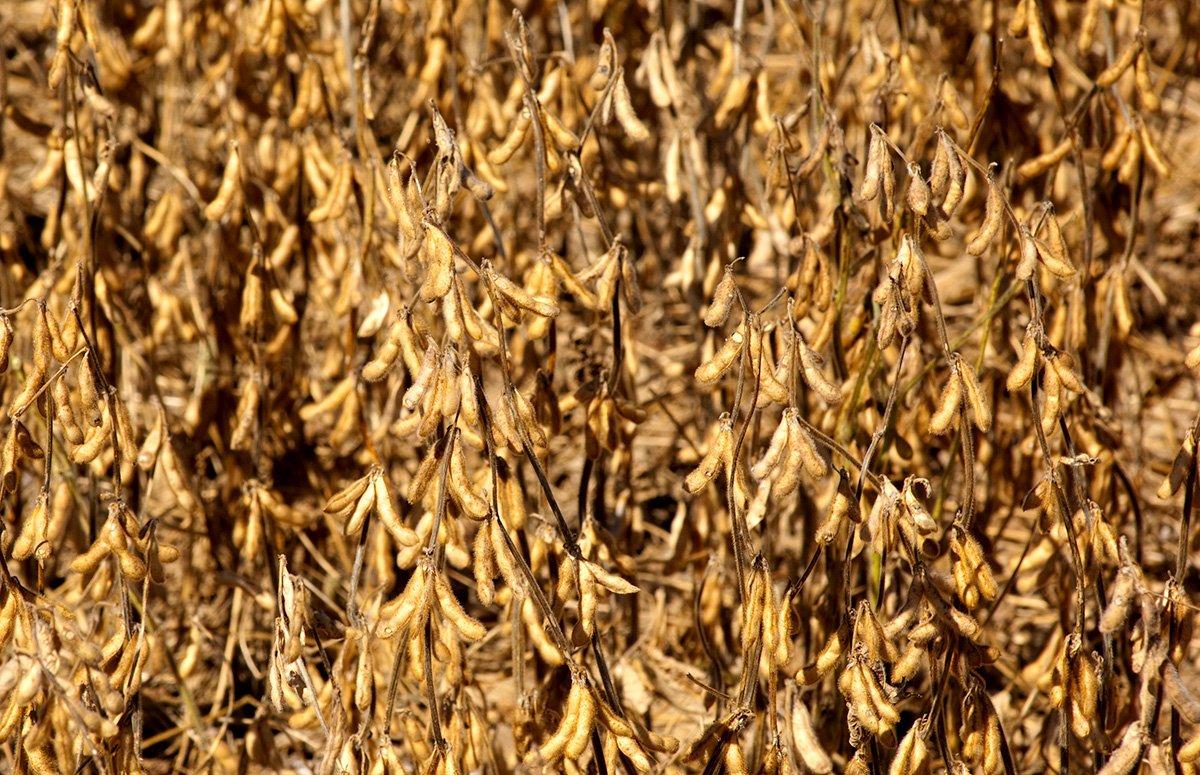Winter is a tough time for wild turkeys, but there are habitat improvements you can make to help them emerge healthy and ready for the spring breeding season
The gobbler began to stir with the first rays of morning light. He gave his body a shake to remove the accumulated snow that had piled onto his feathers during the night. As he surveyed the area around his cedar roost tree, he could see a blanket of white.
This was his third winter, and by now he knew what he needed to do to survive. He stood patiently on the limb, waiting on warming sunlight, in no hurry to fly down. He could hear the other longbeards that shared his roost area begin to stir. Once the sun was fully above the horizon, the group of mature toms would pitch down into the nearby hardwood drain and go about the task of finding enough food to get them through the day.
It isn't easy to be a wild turkey in the winter. Surprisingly, winter mortality is relatively low. Studies have shown that survival rates average 70-100 percent during normal winters, and can dip down as low as 50-60 percent during extremely harsh northern winters. A mature wild turkey may lose up to 40 percent of its body weight before spring.
When it comes to winter survival, finding enough food is one of the chief concerns for a wild turkey, particularly in areas where deep snow is common and persists throughout the winter. Mast is the most important food source, both hard and soft, along with standing ag crops, weed seeds, and any dried and shriveled fruit that might be hanging on from the fall.
Wild turkeys have learned to adjust their movements and habits during cold winter days to take every possible advantage to help them survive. Wild turkeys will roost on south slopes to catch the most sunlight, said Dr. William Gulsby, Professor of Wildlife Management and Ecology at the University of Auburn and one of the lead researchers for the group Turkeys for Tomorrow. They will roost in stands of conifers when temperatures drop, because those trees offer the most thermal protection. Those same conifer stands, mostly cedar and pine, also often provide some open ground below their understory, giving the birds more access to food that might be covered by several inches of snow in other areas.
Mark Hatfield, National Director of Conservation Services for the National Wild Turkey Federation, says mast is the most important factor in wild turkey survival. Mast doesn't just mean acorns, although they play a key role. It can also be other hard mast like beech nuts or pig nut hickory. It can also be soft mast like leftover crabapples and plums. As long as [that soft mast] is persistent, meaning it hangs on the tree and above the snow cover through the winter, it can be beneficial to wild turkeys.
While we have no control over the weather, there are things a landowner or property manager can do to help wild turkeys make it through the winter and emerge into the spring breeding season in top condition.
Manage Timber
Timber management comes in several forms. Of course you can plant more mast producing trees, but that is a long-term project to benefit future generations of both turkeys and turkey hunters. While most oaks fall into this category, trees like some of the modern chestnut hybrids can start to produce highly nutritious mast in as little as three to five years and should definitely factor into your management plan.
A more immediate need is to manage the existing trees you have for maximum mast production. That can be accomplished by thinning competing non-mast producing trees in the area so that the desired trees receive more light, water, and nutrients. You don't have to completely cut down these undesired trees though. In fact, cutting them completely to a stump often encourages multiple sprouts, pulling even more resources from the favored tree. Instead, employ a method known as hack and squirt in which a machete or axe is used to hack deep gashes into the tree's outer layer (through the cambium layer) and then injecting those cuts with herbicide. You need the cuts to be deep enough to cup and hold the herbicide in place.
When employing this method, take care not to destroy understory trees that are beneficial to turkeys. There are a number of studies that show wild turkeys depend heavily on dogwood berries in years with low acorn production. Same goes with beech, persimmon and wild plum, Gulsby said. Learn to identify these trees and others so that you don't remove beneficial trees from the area.
Once you have competing trees removed, consider fertilizing large mast producers to keep them healthy and in peak condition.
Plant More Small Trees and Shrubs
Edge habitat is critical for turkeys, deer, and other wildlife. That area of small trees and shrubs that transitions from mature timber to open upland areas not only provides cover, it can be loaded with food for turkeys and other wildlife.
(Don't Miss: Native Shrubs That Hold Deer on Your Property)
Planting food-producing trees and small shrubs along these areas can pay off with increased food production in just a few years.
Check with local and mail order nurseries for shrubs and small trees like wild plum, persimmon, crabapple, and dogwood. Even berry plants like blackberry, choke cherry, and mulberries can benefit winter turkeys when they hang onto a few dried, shriveled fruits throughout the winter.
A rich, diverse forest must have multiple layers of mast production. Of course you want the large trees like oak, but those mid and low layers of mast producing trees are just as critical, Gulsby said.
Make Your Fall Habitat Prime
Wild turkeys, especially young turkeys going into their first winter, survive better if they are in top physical condition in the fall. You can help by managing your property to provide top turkey habitat. If you look at the perfect turkey habitat from above, it's going to look like a patchwork quilt, with areas of open field, brushy growth, mowed fields, and mature timber, Gulsby said.
Providing all these areas on your property gives young turkeys everything they need going into winter. Mowed and brushy fields provide insects, which are crucial for poult development. Controlled burn areas provide young, tender green growth and more insects. Timber provides mast and roosting areas. And brushy areas offer both protection from predators and easy to reach seeds for the turkeys to eat.
(Don't Miss: 7-best-land-improvements-for-wild-turkeys)
One thing that might not help is free, unlimited feeding of corn. Recent studies have shown that aflatoxin, a naturally occurring toxin produced by the fungus Aspergillus flavus that occurs on corn, can be an issue. It occurs naturally in the environment and tends to build on corn as it lays on the ground. Why is this a problem? Because it has been proven that aflatoxin is detrimental — often fatal — to many birds, including turkeys.
Besides being unhealthy, other studies have shown that poults who spend their summer feeding mostly on corn tend to consume less insects (protein) and go into their first winters in less than prime condition. In areas where corn feeding for deer is common, consider using feeders that keep the corn off the ground and dry, or timed feeding where the corn is consumed in a short period and doesn't lay on the ground for days.
Plant Ag Crops for Turkeys
For a much quicker impact than planting an oak tree, putting in crops to benefit winter turkeys is very effective. Ground crops like chufa can definitely benefit turkeys during the winter in south or southeastern states where snowfall is minimal, Gulsby said. Farther north, where standing snow is an issue, crops like soybeans or grain sorghum could help. Soybeans in particular, when left standing and unharvested, are extremely high in protein and often consumed by turkeys.
Access to clover and alfalfa plots in the summer and and fall will provide direct nutrition and high insect loads for turkeys leading up to winter conditions.
Wild turkeys are a tough, well-adapted species. They've been making it through winter conditions with no help from us for a long time. But recent habitat loss, possibly increased predation on nests and eggs, and other environmental factors have put a dent in the wild turkey population. Hatfield notes that there has been a significant decline in turkey numbers since 2004, perhaps as much as 10-15 percent, or over a million birds. It's clear they could use a little help, and, as lovers of the species, turkey hunters and land managers can lead the way by doing everything we can to keep populations high.

